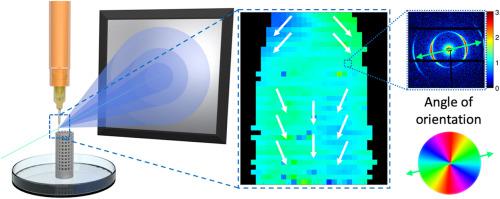Additive Manufacturing ( IF 10.3 ) Pub Date : 2021-09-11 , DOI: 10.1016/j.addma.2021.102289 Adrian Rodriguez-Palomo 1 , Viviane Lutz-Bueno 2 , Manuel Guizar-Sicairos 2 , Roland Kádár 3 , Martin Andersson 4 , Marianne Liebi 1, 5

|
Extrusion-based 3D printing of hexagonal and lamellar lyotropic liquid crystals is a powerful technique to produce hierarchical materials with well-defined anisotropic structure. Tailoring the properties of 3D printed objects requires a precise control of the nanostructure; however, a sufficiently high degree of anisotropy is often not achieved. In this study, scanning small angle X-ray scattering was performed in situ at the exit of the needle during 3D printing. We study the induced anisotropy and nanostructure in hexagonal and lamellar lyotropic liquid crystals. Mapping of extruded filaments during printing revealed that narrower nozzle diameters (370 µm) resulted in less anisotropic structures with a wider distribution of orientation angles across the cross section, while larger nozzle diameters (550 µm) resulted in more anisotropic structures with an overall higher degree of orientation. The apparent wall shear rate is higher for the narrower nozzle, which produces wall slip, resulting in a highly anisotropic shell, and a less aligned filament core. Further examination of the filaments revealed phase transitions due to solvent evaporation. The time scales were of 10–20 min of exposure to atmospheric conditions. Simultaneously, a loss in the macroscopic anisotropy of the hexagonal self-assembled structure was observed. These processes occur during and after extrusion-based 3D printing of liquid crystals and limit the fine control of the final structure. The variability of structures achieved for our different systems highlights the importance of structural characterization during and after extrusion to guarantee high anisotropy and well-defined structures.
中文翻译:

通过散射和双折射成像研究 3D 打印溶致液晶的纳米结构和各向异性
基于挤压的六方和层状溶致液晶的 3D 打印是一种强大的技术,可以生产具有明确各向异性结构的分层材料。定制 3D 打印对象的属性需要对纳米结构进行精确控制;然而,通常无法实现足够高的各向异性。在这项研究中,扫描小角度 X 射线散射是在原位进行的在 3D 打印过程中针的出口处。我们研究了六方和层状溶致液晶中的诱导各向异性和纳米结构。打印过程中挤出细丝的映射显示,喷嘴直径越窄 (370 µm) 导致各向异性结构越少,横截面的取向角分布越宽,而喷嘴直径越大 (550 µm) 导致更多的各向异性结构,整体度数更高的方向。较窄的喷嘴的表观壁剪切速率较高,这会产生壁滑移,导致高度各向异性的壳和不太对齐的长丝芯。对细丝的进一步检查揭示了由于溶剂蒸发引起的相变。时间尺度为暴露于大气条件 10-20 分钟。同时,观察到六边形自组装结构的宏观各向异性损失。这些过程发生在基于挤出的液晶 3D 打印期间和之后,并限制了对最终结构的精细控制。我们不同系统所获得的结构的可变性突出了挤压期间和挤压后结构表征的重要性,以保证高各向异性和明确定义的结构。











































 京公网安备 11010802027423号
京公网安备 11010802027423号